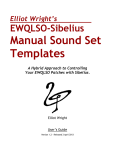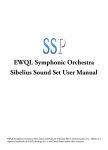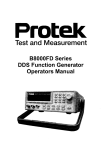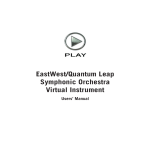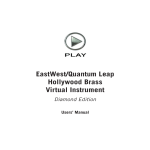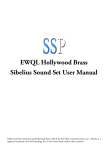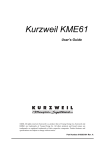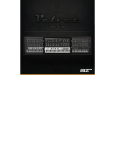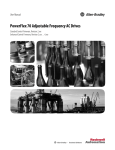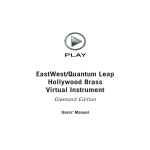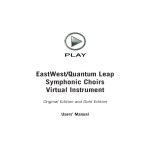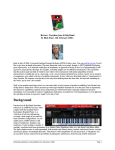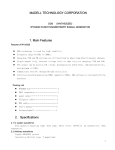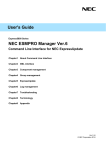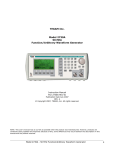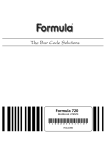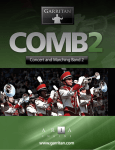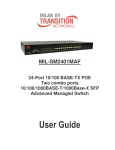Download EWQLSO Gold / Kontakt Conversion Guide
Transcript
Elliot Wright’s EWQLSO-Sibelius Manual Sound Set Templates A Hybrid Approach to Controlling Your EWQLSO Patches with Sibelius. Elliot Wright EWQLSO Gold Conversion Guide Version 1.0 – Released 11 March 2013 Table of Contents Legal / Preface 2 Preface 2 Before You Begin 3 Introduction 3 How to Use the Annexes 3 General Instructions 4 Getting Set Up 4 Overall Procedure 4 Assigning Key-Switches: An Example 4 Annex A: Which Patches, In Which Channels 5 Annex B: Key-Switch Configurations by Patch 8 Other Notes 13 Assigning Key-Switches for English Horn 13 Conclusion 13 1 The EWQLSO/Sibelius 7 Manual Sound Set Templates Elliot Wright EWQLSO Gold Conversion Guide Legal / Preface Preface This document is subject to change without notice, and does not represent a commitment on the part of the author. This document is subject to copyright, and may not be used, reproduced, copied or otherwise distributed for any purpose without written consent from the author. The software described by this document is subject to a License Agreement. This document and the accompanying digital goods were prepared privately by the Author, not by Avid, EastWest, or any other company or individual; views and opinions expressed herein are those of the author alone, and not of any of the software developers or relevant companies. All product and company names are trademarks or registered trademarks of their respective owners. This document is Copyright 2013 by Elliot Wright. All Rights Reserved. These templates and their related files are subject to a license agreement. Elliot Wright has no affiliation with Avid Technology, Inc., EastWest Studios, or any other company mentioned herein or involved in the creation or distribution of similar products or Sound Sets. [email protected] www.ElliotWrightMusic.com 2 The EWQLSO/Sibelius 7 Manual Sound Set Templates Elliot Wright EWQLSO Gold Conversion Guide Chapter 1 Before You Begin Introduction Thank you for purchasing the EWQLSO/Sibelius 7 Manual Sound Set Project Master Template Set. While the playback configurations included in the package should work with any version of EWQLSO, the multis which instruct the PLAY plug-in as to which patches to load into which channels and what kinds of modifications to make – were assembled using EWQLSO Platinum. The result is, although the templates and playback configurations will work no matter what OS or version of EWQLSO you are using, the sounds in the original package can only load automatically if you are using EWQLSO Platinum. For Gold and Silver users, the patches must be loaded and set manually on the first start-up before they can be used. Until such time as a set of Gold multis can be produced by the author, this guide will serve users of EWQLSO Gold to bridge this gap for themselves. The purpose of this guide is to instruct you, the user, as to which patches you will need to load into PLAY after opening the Master Template for the first time; which key-switches to assign to which notes; and also contains other notes on panning and volume adjustment. How to Use the Annexes This guide contains two annexes. Annex A lists every channel in every instance of PLAY, along with which Sound IDs are being used therein. More importantly, Annex A uses these lists to show you which patches will need to be loaded into each channel, and contains brief notes such as “Pan right” or “Turn articulation volume down to -5.2dB”. The most common note however, will be an indicator that a Master KSW Patch needs to have its key-switches re-assigned to a “Normal” configuration or an “Effects” configuration. This is clarified in Annex B. Annex B contains a list of all Master KSW Patches which occur in the template. Under each patch’s name are found two lists of articulations – a “Normal” configuration, and an “Effects” configuration. These show which notes need to be assigned to each key-switch in order to build that configuration. See the next section for further clarifying instructions. Note that patches which are not “Master KS” patches do not generally need to be modified, except for the occasional volume or panning adjustment. Some percussion instruments will have a note beside them in Annex A, instructing you to adjust “Transpose” to a certain number. “Transpose” is found on the player interface in PLAY, in the top-left corner. Most “short” sounds, like staccato, should be turned down by -5.2dB in order to sound “even” with the other sounds. In situations where two instances of the same type of instrument are to be loaded (ie. Two sets of identical patches need to be loaded, as is the case with the two Violin Ensembles, and most brass sections), the patches representing the second instance of that instrument should have their master volume uniformly turned slightly down, and their panning adjusted as desired to show a slight distance between the two sections. In the original template, the two Violin Ensembles are panned so as to appear opposite of one another, for acoustic effect; while brass duos are panned to be slightly, but noticeably, to the left or right of the original player. 3 The EWQLSO/Sibelius 7 Manual Sound Set Templates Elliot Wright Getting Set Up EWQLSO Gold Conversion Guide Chapter 2 General Instructions First, install the templates as outlined in the User’s Manual, by completing all instructions up to and including Chapter 2, Step 3, Paragraph 3. When you try to load the ‘Master’ playback configuration, you will encounter an error, as PLAY attempts to access Platinum patches which do not exist on your computer. Abort all loading for now, but remain on the ‘Master’ configuration. In the ‘Play’ tab, bring up the Playback Configurations dialogue box, and navigate to the ‘Manual Sound Sets’ tab. Here, you will find all 6 instances of PLAY, selectable via a drop-down menu. You can access an instance of PLAY by selecting it in this menu, and clicking “Show” – this will bring the PLAY Plug-in to the front, where you can load patches from your library, and modify them in accordance with the annexes contained herein. Overall Procedure Break the work up into smaller sections. First, load all the patches you need into an instance of PLAY. Save that set as a multi (I recommend saving to an external USB drive, so the data is backed up in case of any future computer difficulty). Close the instance of PLAY and return to Sibelius’ Playback Configurations dialogue. Click ‘Save’ next to the configuration’s name – this will cement into the configuration those patches you just loaded, so you won’t have to load them again later. Repeat this process with each successive instance of PLAY until all instances have had their patches loaded, saved as multis, and the configuration saved again in turn. Next, go into each instance of PLAY and make the smaller changes like panning and volume adjustments. Then go one patch at a time and assign Key-Switches. Save each instance of PLAY again and then save the whole Playback Configuration to make sure you don’t lose any progress. Assigning Key-Switches: An Example Let’s say you are assigning key-switches, starting with Channel 1 of PLAY instance #1. You will notice from Annex A, that Channels 1 and 2 of ‘PLAY 1’ both use the Violin Ensemble key-switch patch “11V KS Master”. Annex A also notes that the first channel’s “KS Master” patch needs to use a “Normal” Configuration, and the second patch uses the “Effects” configuration. Go to Annex B, and find the patch in question (“11V KS Master”). There are two sets of key-switches listed – the top set is identified as the “Normal” configuration, and the bottom set is identified as the “Effects” configuration. Each configuration holds a list of articulations, and which pitch needs to be assigned to that articulation. Since Play 1, Channel 1, “11V KS Master” uses the “Normal” configuration, we’ll start with that. Keep track of your progress by de-selecting the “Active” check-box beside every articulation. Next, go through the list of articulations in the “Normal” configuration in Annex B, and assign key-switching notes accordingly. Re-select the ‘Active’ check-box for each articulation as you assign its new key-switching note. When you are done, some articulations will not have been reassigned – it is important that you now de-select the “Load” check-box next to those unused articulations. Move on to Play 1, Channel 2 – which also uses “11V KS Master”, but under the “Effects” configuration. Repeat the same process as before, but assigning key-switching notes according to the ‘Effects’ configuration found in Annex B for that patch. At the end, as before, remember to de-select the “Active” and “Load” check-boxes for any remaining articulations. Remember that most ‘Short’ articulations (like staccato) will need to be turned down to about -5.2dB to sound “even” with the other articulations. Remember to save each instance of PLAY as a multi for backup purposes; and to save the whole Playback Configuration as you modify it, so that these modifications can load automatically in the future. 4 The EWQLSO/Sibelius 7 Manual Sound Set Templates Elliot Wright EWQLSO Gold Conversion Guide Annex A: Which Patches, In Which Channels Load the following patches into the various instances of PLAY as indicated below: PLAY 1 Ch 1 2 3 4 5 6 7 8 9 10 11 12 13 14 15 16 PLAY 2 "Upper Stgs Low Brs" Sound ID Gold Patch norm 11V KS Master Violin Ensemble I stac 11V KS Master mute 11V QLeg Sord pizz 18V Pizz RR trem 11V Tremolo Violin Ensemble II norm 11V KS Master stac 11V KS Master mute 11V QLeg Sord pizz 18V Pizz RR trem 11V Tremolo Tbn1 norm STB KS Master stacc STB KS Master Tbn2/3 norm STB KS Master stacc STB KS Master Tba norm STU KS Master stacc STU KS Master "Low Stgs Solo Vln" Sound ID Ch 1 Violas 2 3 4 5 6 Cellos 7 8 9 10 Basses 11 12 13 14 15 16 Gold Patch norm VAS KS Master stac VAS KS Master mute VAS QLeg Sord pizz VAS Pizz RR trem VAS Trem norm VCS KS Master stac VCS KS Master trem VCS Trem Leg pizz VCS Pizz RRx3 norm CBS KS Master stac CBS KS Master trem CBS KS Trem pizz CBS Pizz 5 Notes "Normal" configuration "Effects" configuration Turn articulation down -5.2dB "Normal" configuration, Pan Right "Effects" configuration, Pan Right Pan Right Turn articulation down -5.2dB, and Pan Right Pan Right "Normal" configuration "Effects" configuration "Normal" configuration, Panned "Effects" configuration, Panned "Normal" configuration "Effects" configuration Notes "Normal" configuration "Effects" configuration "Normal" configuration "Effects" configuration "Normal" configuration "Effects" configuration The EWQLSO/Sibelius 7 Manual Sound Set Templates Elliot Wright PLAY 3 Ch 1 2 3 4 5 6 7 8 9 10 11 12 13 14 15 16 PLAY 4 "WWs & Upper Brs" Sound ID Clar Bsn Tpt1 Tpt 2/3 Hn1 Hn2/3 Flute Oboe HALL NOISE norm stacc norm stacc norm stacc norm stacc norm stacc norm stacc norm stacc norm EWQLSO Gold Conversion Guide Gold Patch SCL KS Master SCL KS Master BSN KS Master BSN Stacc RRx3 ST2 KS Master ST2 KS Master ST2 KS Master ST2 KS Master SFH KS Master SFH KS Master SFH KS Master SFH KS Master SFL KS Master SFL KS Master SOB KS Master Hall Noise Notes "Normal" configuration "Effects" configuration "Normal" configuration "Effects" configuration "Normal" configuration, Panned "Effects" configuration, Panned "Normal" configuration "Effects" configuration "Normal" configuration, Panned "Effects" configuration, Panned "Normal" configuration "Effects" configuration "PERC" Ch 1 2 3 4 5 6 7 8 9 10 11 12 13 14 15 16 Sound ID Alto Sax (Snare Drum) norm stacc vib Tenor Sax (Tenor Drum) norm vib Timpani norm hard roll Bari Sax (Bass Drum) norm vib Sopranino Sax (Triangle) norm stacc vib Soprano Sax (Cymbals) norm stacc Gold Patch 3 Snares 3 Snares 3 Snares Field Funeral Tenor Field Funeral Tenor Timp Hits LR Timp Hits LR Timp Roll DXF Mod Bass Drum Concert Bass Drum Concert Triangle 2 Triangle 2 Triangle 2 20 French Cymbal 20 French Cymbal 6 Notes Set "Transpose" to 4 Set "Transpose" to 5 Set "Transpose" to 5 Set "Transpose" to 24 Set "Transpose" to 3 Set "Transpose" to 2 Set "Transpose" to 7 Set "Transpose" to 2 The EWQLSO/Sibelius 7 Manual Sound Set Templates Elliot Wright PLAY 5 "Rare & Extra Perc" Ch Sound ID 1 Ehn 2 3 4 5 6 7 8 9 10 11 12 13 14 15 16 PLAY 6 Ch 1 2 3 4 5 6 7 8 9 10 11 12 13 14 15 16 CBsn Aflt Bclar PTpt Piccolo Celesta Vibes Xylophone Tubular Bells Piano Harp "Solo Stgs" Sound ID Violin Solo 1 Violin Solo 2 Viola Solo Cello Solo DB Solo Harpsichord EWQLSO Gold Conversion Guide Gold Patch norm EHN KS Master EH2 KS Master norm CTB KS Master stacc CTB KS Master norm AFL KS Master stacc AFL KS Master norm BCL KS Master stacc BCL KS Master norm PTP KS Master norm PFL KS Master stacc PFL KS Master Celesta Vibes Xylophone Orch Chimes Steinway B Harp Pluck Long norm stac pizz norm stac pizz norm stac pizz norm stac pizz norm stac pizz Gold Patch SVL KS Master SVL KS Master SVL Pizz RR SVL KS Master SVL KS Master SVL Pizz RR SVA KS Master SVA KS Master SVA Pizz RRx3 SVC KS Master SVC KS Master SVC Pizz RRx3 SCB KS Master SCB KS Master SCB Pizz RRx3 Harpsichord 7 Notes Load both E.Hn Master KS Patches into Ch. 1, and look up further instructions in this manual. "Normal" configuration "Effects" configuration "Normal" configuration "Effects" configuration "Normal" configuration "Effects" configuration (Or load a piano from QL Pianos into this Channel) Notes "Normal" configuration, Panned "Effects" configuration, Panned Panned The EWQLSO/Sibelius 7 Manual Sound Set Templates Elliot Wright EWQLSO Gold Conversion Guide Annex B: Key-Switch Configurations by Patch The following tables outline which pitches to assign to the various articulations of each patch, depending on whether you require that patch’s “Normal” configuration, or its “Effects” configuration: 11V KS Master C# 1 Harmonics CBS KS Master C# 1 C 1 Bartok Pizz RR C1 E 6 FX B 0 Trill WT B 0 Trill WT B 0 Trill WT D 6 Cresc A 0 Tremolo "Normal" Configuration C# 1 VCS KS Master C 1 Run Simulator A# 0 Trill HT G# 0 Grand Detache G 0 SusVib A# 0 Trill HT A# 0 Trill HT A 0 Tremolo G# 0 Exp Fast G 0 Sus A 0 Tremolo C# 6 FortePiano C 6 Tremolo G# 0 G 0 Qleg B 5 SusVib F# 0 Col Legno RR F# 0 Col Legno RR F 0 Qleg Flaut F 0 Qleg Flaut F 0 Bartok Pizz A 5 sfz E 0 ExpDim E 0 Exp Leg Acc E 0 Exp Cresc G 5 ExpFst D# 0 Exp D# 0 D 0 LyrB D 0 Sul Pont C# 0 Exp Slow C 0 Lyr-Leg C 0 ExpLeg B -1 Stac RR B -1 Stac RR A -1 SusLeg C1 F# 0 Col Legno RR A# 5 Slaps D# 0 Exp Vib C# 0 LyrA A# -1 Qleg "Effects" Configuration VAS KS Master D 0 Exp Lyr B -1 Marc RR A# -1 Port A -1 SusLeg A -1 SusVib C1 F 5 ExpLeg C# 0 ExpLyrFst C 0 ExpVibFst A# -1 Qleg F# 5 Exp C1 E 5 SusVibSft D 5 Quick Up/Dn C# 5 Port C 5 SusLeg E6 B0 B0 B0 D6 A# 0 A# 0 A# 0 C# 6 A 0 Scratch FX A0 A0 C6 G 0 Clusters G0 G0 B5 th F# 0 F# 0 A# 5 th F0 F0 A5 F# 0 5 Slide Dn F 0 5 Slide Up E 0 Psycho Rip E0 E0 G5 D# 0 D# 0 F# 5 D 0 Mart U/D D0 D0 F 5 sfz C 0 Mart U/D Marc C 0 Marc Shrt C0 E5 D# 0 B -1 Quick Up/Dn A# -1 Spic 2 RR A -1 Stac RR B -1 Mart U/D A# -1 B -1 Mart U/D A# -1 A -1 Stac RR A -1 Marc RR 8 D 5 Mart U/D C# 5 C 5 Quick Up/Dn The EWQLSO/Sibelius 7 Manual Sound Set Templates Elliot Wright SVL KS Master C# 1 SVC KS Master SCB KS Master C# 1 C# 1 C1 C1 E6 B 0 Trill WT B 0 Trill WT B0 D6 A# 0 C# 6 A0 A0 C6 G# 0 G# 0 A0 "Normal" Configuration SVA KS Master C 1 Slur A# 0 Trill HT G# 0 LegVib G 0 SusVib Hrd F# 0 NonVib Sft A# 0 Trill HT G 0 Qleg G 0 SusLeg F# 0 B 5 SusLeg F# 0 ExpUp A# 5 F 0 SusVib Sft F0 F 0 ExpDn A5 E 0 Exp2 E 0 ExpLeg E0 G 5 ExpLeg D# 0 Exp Cresc D# 0 Exp3 D 0 Exp p D 0 Exp1 C# 0 Exp1 C# 0 Exp2 C 0 Exp-Leg B -1 Stac RR A# -1 SusLeg A -1 Qleg ff "Effects" Configuration EWQLSO Gold Conversion Guide D# 0 DblBow D 0 DblBow Exp F# 5 LyrLeg F 5 Lyrical C# 0 C 0 ExpVibSft C 0 ExpVib B -1 Mart RR B -1 Marc A# -1 NonVib RR A# -1 NonVib A -1 SusVib ff A -1 SusVib Smooth ff E 5 Exp D 5 MarcRR C# 5 SusNonVib C 5 SusVib ff C1 C1 C1 E6 B0 B0 B0 D6 A# 0 A# 0 A# 0 C# 6 A 0 8vb Slide Dn A0 A0 C6 G 0 8va Slide Up G 0 8va Slide Up G0 B5 F# 0 Col Legno RR F# 0 Col Legno RR th F# 0 Col Legno RR A# 5 Col Legno RR F 0 5 SlideUp F0 F0 A5 E 0 Slur E0 E0 G5 D# 0 D# 0 D# 0 F# 5 D0 D0 D 0 ExpUp F5 C 0 Marc NonVib Hrd C 0 Marc Hrd RR C 0 ExpDn E5 B -1 Mart U/D A# -1 A -1 Stac RR B -1 B -1 Mart U/D A# -1 A# -1 A -1 Mart RR 9 A -1 Marc D 5 MartRR C# 5 Spicatto RR C 5 MarcRR The EWQLSO/Sibelius 7 Manual Sound Set Templates Elliot Wright PFL KS Master C1 C 1 Gliss C 1 Gliss C1 B 0 Trill WT B 0 Trill WT B 0 Trill WT B 0 SusLeg B 0 Trill WT A 0 Flutter G# 0 G# 0 G 0 Qleg G 0 SusVib F# 0 Psycho Fall F# 0 Fall A# 0 Trill HT C# 1 Fall EH2 KS Master C# 1 A# 0 Trill HT C# 1 Fall EHN KS Master C 1 8va RunUP A0 "Normal" Configuration SOB KS Master C# 1 8va RunDN A# 0 Trill HT A# 0 Legato C# 1 Port A# 0 Trill HT A0 A0 G# 0 G# 0 G# 0 G0 G0 F# 0 F# 0 G 0 SusVib F# 0 Sfz A 0 Port-Leg F 0 Gliss F 0 Grace Notes F 0 Grace F 0 Grace Notes F 0 Grace Notes E0 E 0 Slw Exp2 E0 E0 E0 D# 0 SusNonVib D0 C# 0 Exp Leg C 0 Exp B -1 Stacc RRx3 A# -1 SusLeg A -1 SusVib ff C 1 Rips up 5 D# 0 Slow Exp D# 0 NonVib D 0 ExpLeg D 0 Exp p C# 0 Lyrical C# 0 Exp Vib C 0 LyrLeg C 0 ExpLeg B -1 Stac A# -1 SusLeg A -1 Qleg ff A -1 ffQleg C1 rd B0 A# 0 8va Run U/D A# 0 8va Run U/D A 0 8va RunDN A 0 8va RunDN G 0 8va RunUP G 0 8va RunUP F# 0 F 0 Fall E 0 Gliss E 0 Grace Notes D# 0 D# 0 D0 D0 C0 C0 B -1 A -1 Stacc RRx3 D# 0 NonVib D 0 ExpLeg +Slide D# 0 Qleg C# 0 C# 0 ExpLeg C 0 Exp B -1 StacRRx3 A# -1 A -1 SusVib D0 C 0 Exp B -1 StaccRRx3 A# -1 A -1 Sus ff EHN KS Master: Make all articulations "Active", but only check the "Load" box on 'Release Trails' and any articulations that are listed in BOLD. EH2 KS Master: Assign Key-switches as shown, and "Activate" all articulations, but only "Load" the two 'Trill' articulations and the 'Release Trails'. F# 0 Psycho Run DN RR F 0 Psycho Fall A# -1 B -1 StacRRx3 A# -1 SusLeg th B 0 Rips Up 3 "Effects" Configuration SFL KS Master EWQLSO Gold Conversion Guide Note that when working with the English Horn, you must place a KSW-note on the bottom space of the key-switching staff to turn off the trill, before selecting another articulation. B -1 Shrt Stac A# -1 A -1 Stac 10 The EWQLSO/Sibelius 7 Manual Sound Set Templates Elliot Wright AFL KS Master C# 1 CTB KS Master BCL KS Master C# 1 8va RunDN C 1 8va RunUP E6 E6 E6 B0 B 0 Trill WT D 6 Trill WT D6 D6 C# 6 C# 6 C6 C6 C6 B 5 NonVib B 5 Sus B 5 Sus A0 "Normal" Configuration BSN KS Master C 1 Run U/D A# 0 G# 0 G 0 SusVib F# 0 A# 0 Trill HT A0 C# 6 Trill HT G# 0 Qleg G 0 SusNonVib F# 0 A# 5 A# 5 A# 5 F0 F 0 Grace Notes A5 A5 A5 E 0 ExpLegLyr E0 G5 G 5 Legato G 5 ExpFst D# 0 SusNonVib D 0 ExpLeg C# 0 C 0 Exp B -1 StaccRRx3 A# -1 Legato A -1 ffSusLeg D# 0 D 0 ExpSlowCresc F# 5 ExpLngCresc F# 5 Exp F# 5 F 5 ExpShrt F 5 ExpShort F 5 SusLeg E 5 ExpLeg E 5 ExpLeg E 5 ExpLeg D 5 StaccRRx3 D5 D 5 StaccRRx3 C# 0 ExpFast C 0 ExpLeg B -1 Stac A# -1 Port A -1 SusLeg ff C# 5 SusLeg C# 5 Port Leg C# 5 PortLeg C 5 Qleg ff C 5 SusLeg ff C 5 ff Qleg C1 C1 E6 E6 E6 B0 B0 D6 D6 D6 A# 0 Run U/D "Effects" Configuration SCL KS Master EWQLSO Gold Conversion Guide A# 0 8va Run U/D C# 6 C# 6 C# 6 A0 A 0 8va RunDN C6 C6 C6 G0 G 0 8va RunUP B5 B5 B5 A# 5 A# 5 F# 0 F# 0 A# 5 F0 F0 A5 A 5 Gliss A5 E0 E 0 Grace Notes G5 G 5 Grace Notes G 5 Gliss D# 0 D# 0 F# 5 F# 5 F# 5 D0 D0 F5 F5 F5 C0 C0 E5 E5 E5 D5 D5 D 5 Marc C# 5 C# 5 B -1 A# -1 A -1 StaccRRx3 B -1 Marc A# -1 A -1 Stac C 5 StaccRRx3 11 C 5 StaccRRx3 C# 5 C 5 StaccRRx3 The EWQLSO/Sibelius 7 Manual Sound Set Templates Elliot Wright "Normal" Configuration SFH KS Master ST2 KS Master STB KS Master STA KS Master PTP KS Master C# 1 C# 1 C1 C1 E 6 Mute Sus E 6 Mute Sus C1 B0 B0 D6 D6 B 0 Trill WT A# 0 A# 0 C# 6 C# 6 A0 A0 C6 C6 G# 0 G# 0 G 0 Sus F# 0 G 0 Sus F# 0 Falls C# 1 A# 0 Trill HT A0 G# 0 B 5 Sus A# 5 B 5 Sus A# 5 G0 F# 0 F 0 SfzCresc F 0 Rips A 5 Bass Sfz Cresc A 5 Sfz F0 E0 E0 G5 G5 E0 D# 0 D# 0 F# 5 F# 5 D# 0 D0 D0 F5 F 5 Exp E 5 SusLeg E 5 Exp Leg D 5 StaccRRx3 D5 C# 0 C0 B -1 StacRR A# -1 SusLeg A -1ff Qleg "Effects" Configuration EWQLSO Gold Conversion Guide C# 0 ExpVib C 0 QlegVib B -1 StaccRRx5 A# -1 Port A -1 Qlegff C# 0 C# 5 Port C# 5 StaccRRx3 C 5 Qleg ff C 5 ff Sus Leg C1 C 1 3 Sec Cresc Flutter E6 E6 B0 B 0 Flutter Cresc Fst D6 D6 A# 0 A# 0 2 Sec Cres C# 6 C# 6 A0 A 0 1Sec Cresc C6 C6 G0 G 0 8va Slide UP B5 B5 A# 5 A# 5 F# 0 F# 0 F0 F 0 Falls A5 A5 E0 E 0 Rips G5 G5 D# 0 D# 0 F# 5 F# 5 D0 D0 F5 F5 C0 C 0 MarcVibLng E5 E5 D 5 Marc D 5 Marc B -1 Marc A# -1 A -1 StacRR B -1 Marc A# -1 A -1 StaccRRx5 D0 C# 5 C 5 StaccRRx3 12 C# 5 C 5 StaccRRx3 C 0 Marc B -1 StaccRR A# -1 Sus A -1ff SusLeg The EWQLSO/Sibelius 7 Manual Sound Set Templates Elliot Wright Assigning Key-Switches for English Horn EWQLSO Gold Conversion Guide Other Notes In order to access the articulations in the EHN KS Master patch, while still having the ability to trill (only found in the EH2 KS Master patch), both English Horn patches have been loaded into the same channel, and are being played simultaneously. This creates a need for the EH2 KS Master patch to be able to turn on and off its ‘Trill’ articulations, without later playing trills overtop of EHN KS Master’s notes. The solution is this: a pair of less-useful key-switches in the EHN KS Master patch are assigned to the key-switching notes normally reserved for ‘Trill’ articulations, but no sounds are loaded into them. This way, placing a note on the KSW staff in the score to indicate a trill will play both the ‘silenced’ key-switch in the EHN KS Master patch, and the ‘trill’ articulation in the EH2 KS Master patch, thus activating a trill in the latter while preventing unwanted sound from the former. The same operation must be applied in the reverse. Most articulations in the EH2 KS Master patch are prescribed through Annex B to be “Activated” but not “Loaded”, so that placing a key-switching note in most other places on the KSW-staff will result in a “silenced” key-switch being played on EH2 KS Master (essentially ‘turning off’ the trill articulation) and activating the desired key-switch in EHN KS Master. To achieve this, simply follow the instructions in Annex B when assigning key-switching notes to the two patches: EHN KS Master: Make all articulations "Active", but only check the "Load" box on 'Release Trails' and any articulations that are listed in BOLD. EH2 KS Master: Assign Key-switches as shown, and "Activate" all articulations, but only "Load" the two 'Trill' articulations and the 'Release Trails'. Note: Depending on how PLAY reacts to this, you may get a better result by not activating any articulations except for ‘Release Trails’ and the two ‘Trill’ articulations; if you encounter problems, try this first and see if it resolves it. Remember that because of this specific circumstance, when working with the English Horn, you must place a KSW-note on the bottom space of the key-switching staff to turn off the trill, before selecting another articulation. This will prevent unwanted articulations from sounding, following a trilled note. Conclusion As mentioned before, make sure to save you Playback Configuration, and also save each instance of PLAY as a multi for backup purposes. Thank you for your support, interest and patience in this exciting and continually evolving experiment in pairing the power of Sibelius notation software with the realism of EWQLSO, in a sequencer-like application. I sincerely hope that this guide will help you to get more out of both pieces of software. Cheers! Elliot Wright [email protected] www.ElliotWrightMusic.com 13














